The mouse elevated cross maze market is expected to expand from USD 728.4 million in 2025 to USD 1,232.4 million by 2035, advancing at a CAGR of 5.4%. During this period, market share distribution is likely to shift due to technological innovations, regional adoption patterns, and the emergence of new competitors. Established players with advanced product portfolios, including automated tracking systems, high-precision sensors, and data integration software, are positioned to gain a larger share. Their focus on enhancing accuracy, reproducibility, and ease of use strengthens their position in preclinical research, neurobehavioral studies, and pharmaceutical testing.
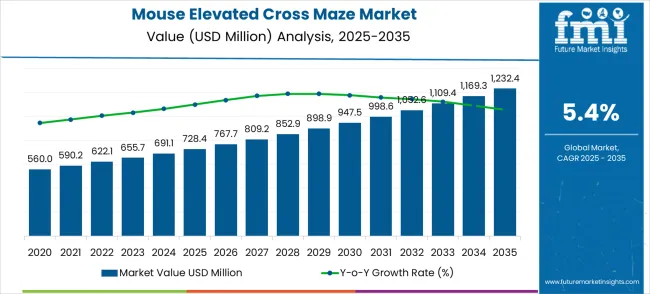
Smaller manufacturers and generic product suppliers may experience relative share erosion as laboratories and research institutions increasingly prefer high-performance and fully integrated solutions. Additionally, regional dynamics contribute to shifts in market share. North America and Europe, which dominate the market due to strong research infrastructure, continue to maintain significant shares, while growth in Asia Pacific, Latin America, and the Middle East offers opportunities for new entrants and product differentiation. Strategic partnerships, product customization, and expansion into emerging regions help leading companies consolidate their market position.
| Metric | Value |
|---|---|
| Estimated Value in (2025E) | USD 728.4 million |
| Forecast Value in (2035F) | USD 1,232.4 million |
| Forecast CAGR (2025 to 2035) | 5.4% |
Emerging trends include automated tracking systems and video-based behavioral analysis for improved accuracy and reproducibility. Manufacturers are developing modular, adjustable, and easy-to-clean maze designs for versatile research applications. Adoption is rising in high-throughput screening and multi-parameter behavioral studies. AI-driven analytics and machine learning tools are enabling detection of subtle behavioral patterns. Partnerships between equipment suppliers, academic institutions, and biotech companies are fostering tailored solutions for specialized experiments. Increasing focus on precise behavioral quantification, efficient drug development, and adherence to animal welfare standards continues to shape global demand for Mouse Elevated Cross Maze systems.
The mouse elevated cross maze market is distributed across academic and behavioral neuroscience research at 42%, pharmaceutical drug discovery at 28%, preclinical toxicology testing at 15%, cognitive and anxiety studies at 10%, and specialty research at 5%. Academic laboratories lead adoption, using the maze to evaluate anxiety, spatial memory, and exploratory behavior in rodents. Pharmaceutical companies employ it for preclinical testing of anxiolytic, antidepressant, and cognitive-enhancing compounds. Preclinical toxicology studies use the maze to identify neurological or behavioral side effects. Specialty applications include sleep research, stress response experiments, and environmental enrichment studies. Market growth is driven by increasing investment in neuroscience, behavioral pharmacology, and rodent-based preclinical research.
Market expansion is being supported by the increasing global demand for reliable behavioral assessment tools and the corresponding need for standardized anxiety testing equipment that can provide consistent and reproducible results across diverse research applications. Modern pharmaceutical companies and research institutions are increasingly focused on implementing behavioral testing solutions that can reduce study variability, enhance data quality, and provide validated anxiety assessment protocols for drug development programs. Mouse elevated cross mazes' proven ability to deliver standardized anxiety assessment, reproducible behavioral measurements, and versatile research applications make them essential equipment for contemporary neuroscience research and pharmaceutical development.
Research facilities' preference for equipment that combines measurement precision with operational reliability and standardization compliance is creating opportunities for innovative behavioral testing implementations. The rising influence of personalized medicine approaches and biomarker development is also contributing to increased adoption of mouse elevated cross mazes that can provide detailed behavioral analysis without compromising animal welfare standards.
The mouse elevated cross maze market is growing as research in behavioral neuroscience and pharmacology expands. Rat specifications with arm length of 425 mm and arm width of 120 mm dominate the animal model segment with approximately 34% of the market share, reflecting their widespread use in preclinical testing for anxiety and exploratory behavior. In terms of application, antianxiety drug development leads with around 59% of the market, driven by increasing research and testing of anxiolytic compounds. Market growth is supported by rising investment in neuropharmacology, standardization of behavioral assays, and the need for reliable, reproducible models in preclinical research.
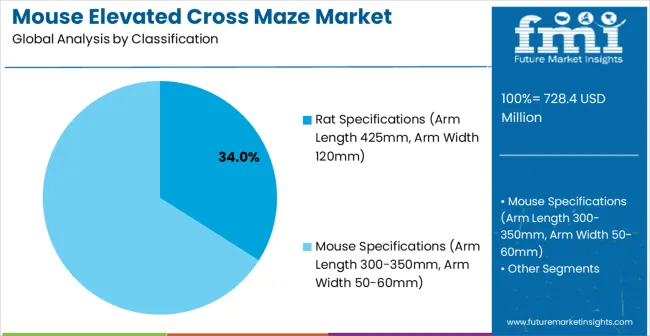
Rat models with arm length of 425 mm and arm width of 120 mm hold approximately 34% of the animal model segment, making them the preferred choice for preclinical behavioral studies. These models provide consistent locomotor activity and exploration patterns, allowing precise measurement of anxiety-related behaviors. Leading suppliers include Panlab, Harvard Apparatus, TSE Systems, and Ugo Basile. Rat models are preferred for their larger size compared to mice, enabling easier observation and data collection. They are compatible with automated tracking systems and video analysis software, which improves reproducibility and reduces observer bias in behavioral experiments.
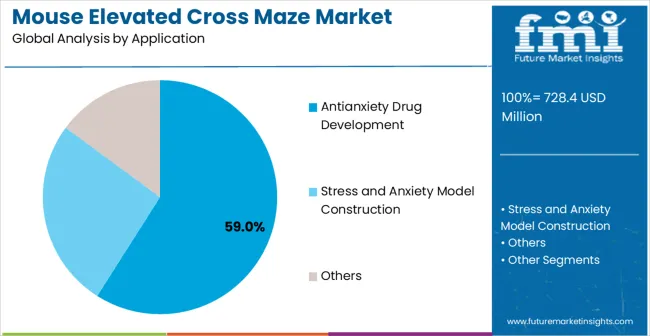
Antianxiety drug development accounts for approximately 59% of the application segment, making it the largest market for mouse elevated cross maze use. These mazes are extensively employed to assess anxiolytic effects of new compounds, measure open-arm time, and quantify exploratory behaviors in preclinical trials. Suppliers such as Panlab, Harvard Apparatus, TSE Systems, and Ugo Basile provide mazes optimized for durability, standardization, and reproducibility. Segment growth is driven by increasing demand for novel antianxiety therapeutics, regulatory requirements for preclinical behavioral evaluation, and the rising focus on neuropharmacology research. The maze remains a core tool for early-stage drug efficacy testing.
The mouse elevated cross-maze market is advancing rapidly due to increasing demand for standardized behavioral assessment tools and growing adoption of automated analysis systems that provide enhanced measurement precision and data reproducibility across diverse neuroscience research applications. The market faces challenges, including high equipment costs for advanced systems, the complexity of behavioral data interpretation, and the need for specialized training for optimal system utilization. Innovation in video tracking technologies and artificial intelligence-based analysis continues to influence product development and market expansion patterns.
The growing adoption of automated video tracking systems and computer-based behavioral analysis is enabling research facilities to achieve more efficient data collection with improved accuracy, reduced manual scoring time, and enhanced behavioral parameter measurement capabilities. Advanced tracking systems provide improved research productivity while allowing more comprehensive behavioral analysis and consistent data quality across various experimental conditions and research environments. Manufacturers are increasingly recognizing the competitive advantages of automation capabilities for research efficiency and data standardization requirements.
Modern elevated cross maze producers are incorporating artificial intelligence algorithms and machine learning technologies to enhance behavioral pattern recognition, automate complex data analysis, and provide predictive behavioral modeling capabilities for research applications. These technologies improve research efficiency while enabling new applications, including real-time behavioral assessment and predictive anxiety modeling. Advanced AI integration also allows researchers to support sophisticated data analysis and research insights beyond traditional behavioral scoring methods.
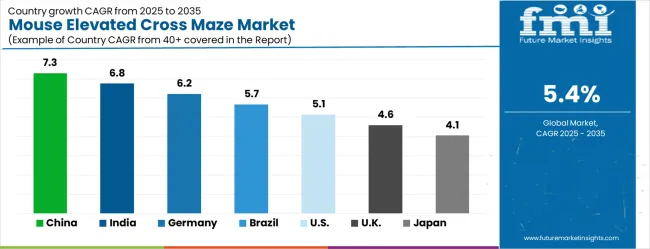
| Country | CAGR (2025-2035) |
|---|---|
| China | 7.3% |
| India | 6.8% |
| Germany | 6.2% |
| Brazil | 5.7% |
| USA | 5.1% |
| UK | 4.6% |
| Japan | 4.1% |
The mouse elevated cross maze market is experiencing strong growth globally, with China leading at a 7.3% CAGR through 2035, driven by the expanding neuroscience research sector, growing pharmaceutical industry, and significant investment in behavioral research infrastructure development. India follows at 6.8%, supported by the rapid expansion of research institutions, increasing biotechnology sector growth, and growing focus on preclinical research capabilities. Germany shows growth at 6.2%, priortizing technological innovation and advanced research equipment manufacturing. Brazil records 5.7%, focusing on academic research expansion and pharmaceutical sector development. The USA demonstrates 5.1% growth, driven by established neuroscience research infrastructure and pharmaceutical industry demand. The UK exhibits 4.6% growth, supported by academic research excellence and biotechnology sector expansion. Japan shows 4.1% growth, priortizing preision instrumentation and advanced research methodologies.
The report covers an in-depth analysis of 40+ countries, Top-performing countries are highlighted below.
China leads the market with a 7.3% CAGR, well above the global 5.4%. Adoption is concentrated in Shanghai, Beijing, and Jiangsu, where preclinical neuroscience research facilities are expanding. Manufacturers such as Panlab, TSE Systems, and Med Associates supply high-precision mazes with automated tracking and video analysis features. The growth is driven by increasing research in anxiety, memory, and behavioral neuroscience studies. Integration with software for data logging and analytics is common in 45% of laboratories. Animal welfare compliance and standardized protocols are increasingly implemented to improve reproducibility. Large-scale pharmaceutical and academic research institutes contribute to adoption, while portable and modular maze systems are gaining preference for flexible laboratory setups.
India shows a CAGR of 6.8%, above the global 5.4%. Adoption is concentrated in Maharashtra, Karnataka, and Telangana, where neuroscience and pharmacological research is growing. Suppliers like TSE Systems, Med Associates, and Panlab provide mazes integrated with automated behavioral monitoring software. Preclinical studies in anxiety, neurodegenerative disorders, and cognition are primary applications. Portable and modular maze designs are increasingly preferred for research labs with limited space. Government-funded research programs and private pharmaceutical R&D centers account for 42% of installations. Adoption is further supported by collaborative projects between universities and biotech startups focusing on neuropharmacology.
Germany records a CAGR of 6.2%, above the global 5.4%. Adoption is concentrated in Berlin, Munich, and Heidelberg, where pharmaceutical and neuroscience research institutes dominate. Suppliers such as Panlab, TSE Systems, and Med Associates offer mazes with automated video tracking, telemetry integration, and standardized protocols. The growth is driven by neurodegenerative disorder studies, anxiety models, and behavioral pharmacology research. Integration with laboratory information management systems (LIMS) improves data consistency and reproducibility. Animal welfare and ethical compliance are focused, supporting adoption in 38% of laboratories. Modular setups and software-assisted tracking are widely deployed for high-throughput studies.
Brazil grows at 5.7% CAGR, slightly above the global 5.4%. Adoption is concentrated in São Paulo, Rio de Janeiro, and Minas Gerais, driven by neuroscience and pharmacological research. Suppliers like TSE Systems, Panlab, and Med Associates provide mazes with automated scoring, video tracking, and anxiety-related behavioral protocols. Academic research centers and pharmaceutical companies contribute 45% of installations. Portable maze designs are favored for flexible lab use. Studies focusing on stress models, anxiety, and memory evaluation drive demand. Regional funding programs for neuropharmacology research enhance adoption, while software-assisted analysis is implemented in 30% of labs.
The USA grows at 5.1% CAGR, slightly below global 5.4%. Adoption is concentrated in Boston, California, and Maryland, where pharmaceutical R&D and academic neuroscience centers are active. Suppliers such as Med Associates, Panlab, and TSE Systems provide mazes with integrated video tracking, telemetry, and automated scoring. Preclinical studies in anxiety, depression, and cognition drive demand. Large-scale pharmaceutical companies account for 50% of installations, with modular and portable maze designs applied in 40% of labs. Integration with LIMS and advanced analytics is common in 35% of research projects. Regulatory compliance and animal welfare guidelines are key adoption factors.
The UK records 4.6% CAGR, below global 5.4%. Adoption is concentrated in London, Cambridge, and Edinburgh, where academic and pharmaceutical research dominates. Suppliers like TSE Systems, Panlab, and Med Associates provide mazes equipped with video tracking and automated scoring. Preclinical research in anxiety, stress, and memory evaluation represents 42% of demand. Modular maze setups are preferred in 35% of smaller labs to maximize flexibility. Regulatory compliance and adherence to animal welfare standards are critical for adoption. Government and private funding programs for neuroscience research support continued market activity.
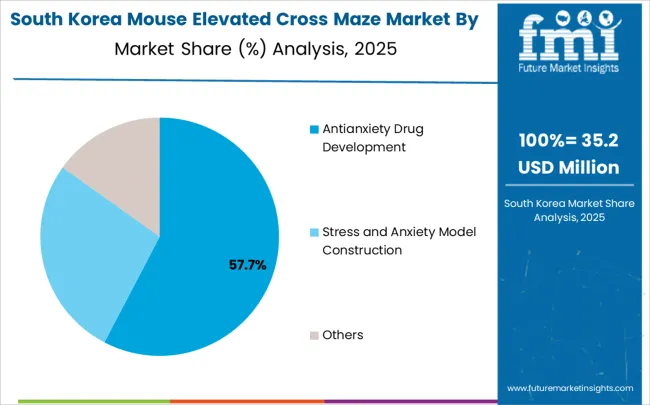
Japan exhibits 4.1% CAGR, below global 5.4%. Adoption is focused in Tokyo, Osaka, and Kyoto, where pharmaceutical and academic neuroscience research is concentrated. Suppliers including Panlab, TSE Systems, and Med Associates provide mazes with automated scoring, video tracking, and telemetry integration. Preclinical studies in cognition, anxiety, and neurodegenerative disorder research account for 40% of adoption. Portable and modular mazes are increasingly preferred in labs with space constraints. Advanced analytics and integration with laboratory management systems improve data reliability. Adoption is supported by government-funded neuroscience research and collaborations between universities and biotech companies.
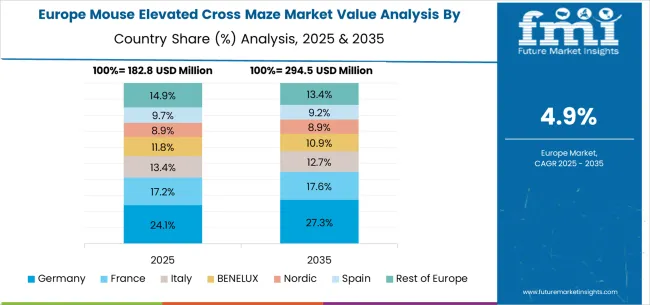
The mouse elevated cross maze market in Europe is projected to grow from USD 169.3 million in 2025 to USD 286.6 million by 2035, registering a CAGR of 5.4% over the forecast period. Germany is expected to maintain its leadership position with a 30.2% market share in 2025, moderating slightly to 29.8% by 2035, supported by its strong research infrastructure, advanced neuroscience research capabilities, and comprehensive equipment manufacturing networks serving major European markets.
The United Kingdom follows with a 24.5% share in 2025, projected to reach 24.7% by 2035, driven by robust academic research excellence, an established biotechnology sector, and strong demand for precision research equipment across neuroscience and pharmaceutical research applications. France holds an 18.3% share in 2025, rising to 18.5% by 2035, supported by expanding neuroscience research programs and increasing adoption of automated behavioral analysis systems in academic institutions. Italy records 11.2% in 2025, inching to 11.3% by 2035, with growth underpinned by research infrastructure modernization and increasing pharmaceutical research activities. Spain contributes 8.1% in 2025, moving to 8.2% by 2035, supported by expanding academic research capabilities and biotechnology sector development. The Netherlands maintains a 3.4% share in 2025, growing to 3.5% by 2035. The rest of Europe region, including Nordic countries, Eastern Europe, Belgium, Switzerland, and Austria, is anticipated to gain momentum, expanding its collective share from 4.3% to 4.0% by 2035, attributed to increasing adoption of advanced research equipment in Nordic countries and growing neuroscience research activities across Eastern European markets, implementing research modernization programs.
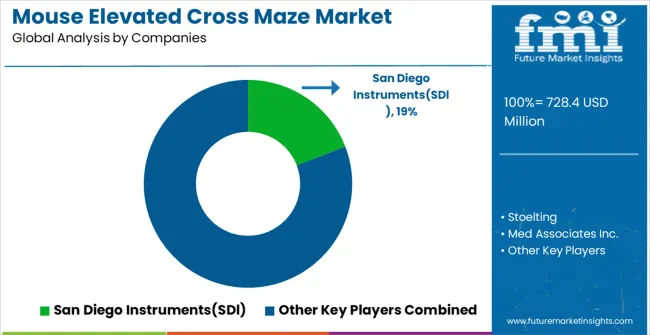
The mouse elevated cross-maze market is characterized by competition among established research equipment manufacturers, specialized behavioral testing system providers, and integrated neuroscience solution companies. Companies are investing in advanced tracking technology research, automated analysis system development, precision engineering improvements, and comprehensive software portfolios to deliver consistent, high-accuracy, and user-friendly behavioral assessment solutions. Innovation in video tracking systems, artificial intelligence integration, and standardized protocol development is central to strengthening market position and competitive advantage.
San Diego Instruments leads the market with a strong market share, offering comprehensive behavioral research equipment with a focus on precision measurement and automated analysis capabilities. Stoelting provides versatile behavioral testing solutions with an focus on research institution markets and educational applications. Med Associates Inc. delivers innovative neuroscience research equipment with a focus on standardized protocols and regulatory compliance. CleverSys specializes in automated behavioral analysis software and video tracking systems. Med Associates focuses on comprehensive research equipment platforms and integrated behavioral assessment solutions.
Mouse elevated cross mazes represent a specialized behavioral testing equipment segment within neuroscience research and pharmaceutical development, projected to grow from USD 728.4 million in 2025 to USD 1,232.4 million by 2035 at a 5.4% CAGR. These standardized behavioral assessment apparatus-primarily rat specifications (arm length 425mm, arm width 120mm) for anxiety testing enable stress and anxiety model construction (USD 271.8 million in 2025) and anti-anxiety drug development in preclinical research applications. Market expansion is driven by increasing neuroscience research funding, growing pharmaceutical industry demand for standardized behavioral protocols, rising adoption of automated video tracking systems, and expanding global research infrastructure requiring validated anxiety assessment tools.
How Research Ethics and Animal Welfare Organizations Could Enhance Standards and Protocol Development?
How Academic Research Institutions Could Advance Scientific Excellence and Innovation?
How Equipment Manufacturers Could Drive Innovation and Research Support?
How Pharmaceutical Companies Could Optimize Drug Development and Regulatory Compliance?
How Regulatory Authorities Could Support Research Quality and Scientific Standards?
How Investors and Financial Enablers Could Support Market Development and Scientific Advancement?
| Items | Values |
|---|---|
| Quantitative Units (2025) | USD 728.4 million |
| Animal Model | Rat Specifications (Arm Length 425mm, Arm Width 120mm), Mouse Specifications (Arm Length 300-350mm, Arm Width 50-60mm), Others |
| Application | Antianxiety Drug Development, Stress and Anxiety Model Construction |
| Regions Covered | North America, Europe, East Asia, South Asia & Pacific, Latin America, Middle East & Africa |
| Countries Covered | United States, Canada, United Kingdom, Germany, France, China, Japan, South Korea, India, Brazil, Australia and 40+ countries |
| Key Companies Profiled | San Diego Instruments, Stoelting, Med Associates Inc., CleverSys, Med Associates, and Ugo Basile |
| Additional Attributes | Dollar sales by animal model and application category, regional demand trends, competitive landscape, technological advancements in tracking systems, automation innovation, AI integration development, and protocol standardization |
The global mouse elevated cross maze market is estimated to be valued at USD 728.4 million in 2025.
The market size for the mouse elevated cross maze market is projected to reach USD 1,232.4 million by 2035.
The mouse elevated cross maze market is expected to grow at a 5.4% CAGR between 2025 and 2035.
The key product types in mouse elevated cross maze market are rat specifications (arm length 425mm, arm width 120mm) and mouse specifications (arm length 300-350mm, arm width 50-60mm).
In terms of application, antianxiety drug development segment to command 59.0% share in the mouse elevated cross maze market in 2025.






Our Research Products

The "Full Research Suite" delivers actionable market intel, deep dives on markets or technologies, so clients act faster, cut risk, and unlock growth.

The Leaderboard benchmarks and ranks top vendors, classifying them as Established Leaders, Leading Challengers, or Disruptors & Challengers.

Locates where complements amplify value and substitutes erode it, forecasting net impact by horizon

We deliver granular, decision-grade intel: market sizing, 5-year forecasts, pricing, adoption, usage, revenue, and operational KPIs—plus competitor tracking, regulation, and value chains—across 60 countries broadly.

Spot the shifts before they hit your P&L. We track inflection points, adoption curves, pricing moves, and ecosystem plays to show where demand is heading, why it is changing, and what to do next across high-growth markets and disruptive tech

Real-time reads of user behavior. We track shifting priorities, perceptions of today’s and next-gen services, and provider experience, then pace how fast tech moves from trial to adoption, blending buyer, consumer, and channel inputs with social signals (#WhySwitch, #UX).

Partner with our analyst team to build a custom report designed around your business priorities. From analysing market trends to assessing competitors or crafting bespoke datasets, we tailor insights to your needs.
Supplier Intelligence
Discovery & Profiling
Capacity & Footprint
Performance & Risk
Compliance & Governance
Commercial Readiness
Who Supplies Whom
Scorecards & Shortlists
Playbooks & Docs
Category Intelligence
Definition & Scope
Demand & Use Cases
Cost Drivers
Market Structure
Supply Chain Map
Trade & Policy
Operating Norms
Deliverables
Buyer Intelligence
Account Basics
Spend & Scope
Procurement Model
Vendor Requirements
Terms & Policies
Entry Strategy
Pain Points & Triggers
Outputs
Pricing Analysis
Benchmarks
Trends
Should-Cost
Indexation
Landed Cost
Commercial Terms
Deliverables
Brand Analysis
Positioning & Value Prop
Share & Presence
Customer Evidence
Go-to-Market
Digital & Reputation
Compliance & Trust
KPIs & Gaps
Outputs
Full Research Suite comprises of:
Market outlook & trends analysis
Interviews & case studies
Strategic recommendations
Vendor profiles & capabilities analysis
5-year forecasts
8 regions and 60+ country-level data splits
Market segment data splits
12 months of continuous data updates
DELIVERED AS:
PDF EXCEL ONLINE
Mouse TNF-α Kit Market Size and Share Forecast Outlook 2025 to 2035
Mouse T Cell Isolation Kit Market Size and Share Forecast Outlook 2025 to 2035
Mouse RNase Inhibitor Market Size and Share Forecast Outlook 2025 to 2035
Rat and Mouse Forced Swimming Test System Market Size and Share Forecast Outlook 2025 to 2035
Wireless Mouse Market
Humanized Mouse Model Market Size and Share Forecast Outlook 2025 to 2035
Cross-chain NFT Market Size and Share Forecast Outlook 2025 to 2035
Cross-species Organ Transplantation Market Forecast and Outlook 2025 to 2035
Cross Interconnection Protection Box Market Size and Share Forecast Outlook 2025 to 2035
Cross Corner Industrial Bags Market Size and Share Forecast Outlook 2025 to 2035
Cross-Linked Polyethylene Market Size and Share Forecast Outlook 2025 to 2035
Cross-Border Road Transport Market Size and Share Forecast Outlook 2025 to 2035
Crossfit Apparel Market Size and Share Forecast Outlook 2025 to 2035
Cross Point Switch Market Size and Share Forecast Outlook 2025 to 2035
Cross Pein Hammer Market Size and Share Forecast Outlook 2025 to 2035
Cross Training Shoes Market Size and Share Forecast Outlook 2025 to 2035
Crossover Market Size and Share Forecast Outlook 2025 to 2035
Cross-Cloud Analytics Market Insights - Growth & Forecast 2025 to 2035
Cross-Belt Sorters Market
Cross-linked Shrink Films Market

Thank you!
You will receive an email from our Business Development Manager. Please be sure to check your SPAM/JUNK folder too.
Chat With
MaRIA